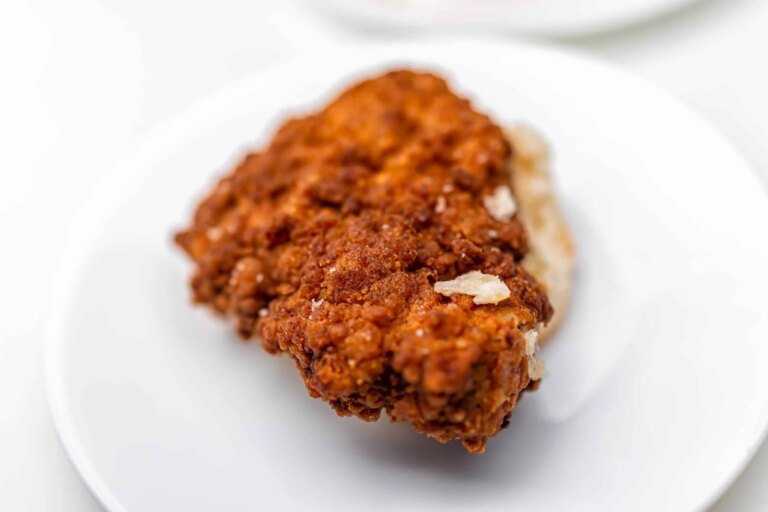In a world where food safety is of utmost concern, a recent controversy involving meat glue has stirred the public, especially those who prioritize mindful eating and wellness. The debate was ignited when a shopper claimed to have found evidence of meat glue in his supermarket steak, raising questions about food integrity and transparency. This incident has left many wondering: What exactly is meat glue, and could it be compromising our health?
What Is Meat Glue and How Is It Used?
Meat glue, or transglutaminase, is an enzyme that acts as a binding agent for proteins. In the food industry, it’s used to bond small pieces of meat together, creating the appearance of a whole, premium cut. This allows producers to present meat products, like steaks or fillets, as higher quality, even though they are essentially restructured from different fragments. You might have consumed meat glue without even realizing it, as it’s often undetectable once the meat is cooked and presented on the plate.
This enzyme works by forming covalent bonds between amino acids, making the individual pieces stick together seamlessly. While this can improve the visual appeal and texture of processed meats, it raises concerns about food authenticity and possible health implications, especially for those seeking transparency in their food choices. Understanding how meat glue operates in the food industry is key to making informed dietary decisions.
The use of meat glue is not limited to beef products alone. It’s also found in various processed foods like fish, chicken, and even some dairy products. Its versatility in the food industry has made it a common additive, often without consumers’ knowledge. While its application is generally considered safe by the Food and Drug Administration (FDA), the lack of transparency on labels continues to fuel debates, especially for health-conscious individuals looking to avoid hidden additives.

Is Meat Glue Dangerous? Understanding the Health Risks
While transglutaminase is approved for use by food regulatory bodies in many countries, its application in processed foods raises several health risks that are important to understand. One of the primary concerns is the potential for bacterial contamination.
When smaller pieces of meat are fused together using meat glue, it can trap bacteria between the fragments. Unlike a whole cut of meat, where bacteria are usually only present on the surface, these restructured products may have bacteria spread throughout. If not cooked thoroughly, harmful bacteria such as E. coli or Salmonella could survive, posing a significant health risk.
Another issue with meat glue is its potential to cause allergic reactions. Transglutaminase is sometimes derived from animal blood or produced through fermentation by bacteria, which can lead to cross-contamination with allergens. People with sensitivities to certain proteins or those with gluten intolerance might experience reactions. Although meat glue itself does not contain gluten, the possibility of cross-contact during processing makes it a concern for those with celiac disease or severe food allergies.
Moreover, the use of meat glue raises ethical concerns about food transparency. Many consumers are unaware that they may be purchasing restructured meat products rather than whole cuts. This lack of transparency can make it difficult for individuals to make informed decisions about what they are eating, leading to a sense of distrust in the food industry. For those who prioritize health and wellness, knowing whether meat glue is present in their food is crucial for maintaining confidence in their dietary choices.
How to Identify Meat Glue in Your Food
Identifying whether meat glue has been used in the products you purchase can be tricky, as it often isn’t openly disclosed on food labels. However, with a few practical tips, you can become more mindful of the products you’re consuming and make informed choices for your health and well-being.
- Check the Ingredients List: One of the easiest ways to identify if meat glue, or transglutaminase, is used in your food is by carefully examining the ingredients list. While it may not always be listed as “meat glue,” it could be labeled as transglutaminase. Other terms like “restructured meat” or “formed meat” may also indicate the use of binding agents.
- Be Wary of Low-Cost Premium Cuts: If you’re purchasing a steak or other high-end meat product at a significantly lower price than expected, it could be a sign that smaller meat pieces have been glued together to look like a whole cut. Meat glue is commonly used in cheaper processed meats to give the appearance of premium quality.
- Look for Freshly Cut Meat: When shopping at a butcher or grocery store, opting for fresh, whole cuts of meat that have been freshly sliced is another way to avoid restructured meat. These cuts are less likely to contain additives like transglutaminase, as they are typically not processed in the same way.
By taking the time to carefully review food labels and being mindful of the products you choose, you can minimize the likelihood of consuming meat glue. This awareness can support your journey toward more transparent and health-conscious eating habits.

Healthy Ways You Can Avoid Meat Glue
For those who are wary of the potential health risks associated with meat glue, there are several healthier and more transparent alternatives to consider.
One of the most reliable options is to choose whole, unprocessed cuts of meat. When you buy a fresh, whole piece of meat from a trusted butcher or farmers’ market, you can be confident that the product hasn’t been restructured or treated with additives like transglutaminase. Whole cuts of meat are generally higher in quality and offer more nutritional value compared to processed or restructured options, allowing you to maintain control over what you’re putting into your body.
In addition to whole cuts, embracing plant-based proteins is another great way to steer clear of the risks posed by meat glue. Proteins derived from plants, such as beans, lentils, tofu, and tempeh, are naturally free of additives and provide excellent sources of essential nutrients. These plant-based options not only support a healthy lifestyle but are also aligned with sustainable and eco-friendly eating habits, making them an attractive choice for those seeking to reduce their consumption of animal products.
Lastly, if you prefer to stick with animal proteins, opting for organic or grass-fed meat can help you avoid hidden additives and promote better health. Organic and grass-fed meat often come with stricter regulations, meaning they are less likely to contain questionable substances like meat glue. Additionally, grass-fed meats typically contain higher levels of omega-3 fatty acids and other beneficial nutrients, making them a more nutritious and ethical choice. By prioritizing whole, minimally processed foods, you can reduce your exposure to additives and make choices that better align with your wellness goals.

My Personal RX on Healthy Consumption and Overall Wellness
As a doctor, I always emphasize the importance of a holistic approach to health. Digestive health, in particular, plays a vital role in our overall well-being, impacting everything from nutrient absorption to mental clarity. To maintain a healthy digestive system and promote full-body wellness, it’s crucial to adopt mindful eating practices and choose foods that support digestion and immune health. Here are my top tips to ensure your digestive system—and overall health—function optimally:
- Eat Whole, Unprocessed Foods: Prioritize whole, natural foods that are rich in fiber to promote gut health. Foods like fruits, vegetables, and whole grains support digestion and provide essential nutrients.
- Take Digestive Enzymes: Consider adding Digestive Enzymes to your routine to support the body’s natural digestion process. These supplements can help optimize nutrient absorption and prevent bloating or discomfort after meals.
- Practice Mindful Eating: Slow down during meals, chew thoroughly, and savor each bite. Mindful eating helps improve digestion and can reduce overeating.
- Stay Hydrated: Drinking enough water throughout the day is key to supporting digestive health. Water aids in breaking down food and helps prevent constipation.
- Incorporate Probiotics: Include probiotic-rich foods like yogurt or fermented vegetables in your diet to promote a healthy gut microbiome, which is essential for digestion and immunity.
- Use a Holistic Health Guide: If you’re experiencing frequent digestive issues, reevaluate your food choices and consult my 50-page Protocol e-book. This comprehensive approach can provide insights into balancing your diet, reducing stress, and living your best life.
- Reduce Stress: High stress levels can negatively impact digestion. Practices like deep breathing, meditation, or gentle exercise can help you manage stress and improve digestive function.
- Exercise Regularly: Regular physical activity stimulates digestion and promotes overall gut health. Aim for at least 30 minutes of movement each day, whether through walking, yoga, or other forms of exercise.
- Get Enough Sleep: Quality sleep is essential for digestion and overall health. Lack of sleep can disrupt your body’s natural processes, including digestion, so aim for 7-9 hours of restful sleep each night.
Sources:
- Bilderbeck, P. (2024a, April 10). Man furious as he claims to have found “meat glue” in his steak from supermarket. UNILAD. https://www.unilad.com/news/food-and-drink/man-accuses-woolworths-meat-glue-steak-011599-20240410
- “Meat glue” poses health risks for consumers | ABC7 Los Angeles | abc7.com. (2021, November 16). ABC7 Los Angeles. https://abc7.com/archive/8642900/
- Faclm, M. G. M. (2024, April 1). What is ‘Meat Glue’? NutritionFacts.org. https://nutritionfacts.org/blog/what-is-meat-glue/












 Subscribe to Ask Dr. Nandi YouTube Channel
Subscribe to Ask Dr. Nandi YouTube Channel










